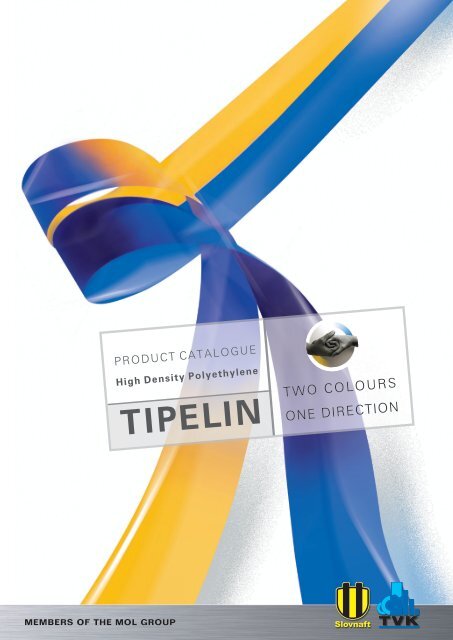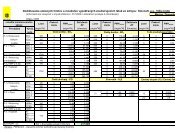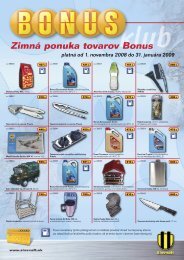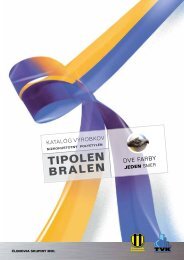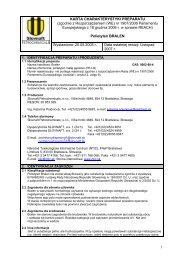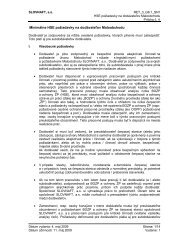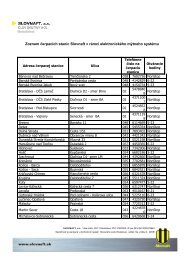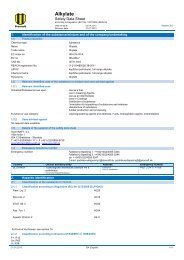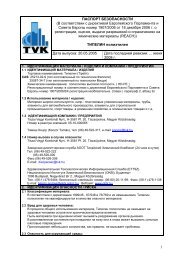Brochure HDPE - TVK
Brochure HDPE - TVK
Brochure HDPE - TVK
You also want an ePaper? Increase the reach of your titles
YUMPU automatically turns print PDFs into web optimized ePapers that Google loves.
PRODUCT CATALOGUEHigh Density PolyethyleneTIPELINTWO COLOURSONE DIRECTIONmembers of the mol groupPETROCHEMICALS
TWO COLOURSONE DIRECTION
IntroductionAlong with petrochemical units of Slovnaft, a.s. in Bratislava, <strong>TVK</strong> Plc. is composing thePetrochemical business in the MOL Downstream Division, which holds leading position in Central Europe’spetrochemical sector and is one of the ten largest polymer producers in Europe.We can highly lean on the refinery integration benefits in the MOL Downstream Division: the securedfeedstock supply, the robust financial background and strong position in the regional markets, togetherwith the high quality products of the optimized production capacities. We keep operational reliability up byregular maintenance programs, carried out at our production units.Our prime objective is maintaining our petrochemical leadership in the Central and Eastern Europeanpolymer markets where the demand growth perspectives exceeds Western European figures.Our advantageous location in the Central European markets and our competitive portfolio of high qualitypolyolefin products - optimized in line with customer requirements - provide a firm basis for exploiting theopportunities arising from the surge of demand for polymers in Central and Eastern Europe.Corporate History1999 MOL acquired minority stake in <strong>TVK</strong> Plc.2001 MOL became majority owner in <strong>TVK</strong> with a stake over 33,34 %2004 MOL acquired majority stake in <strong>TVK</strong> (44,31%) and in Slovnaft (98,4%)MOL Petrochemicals Division established: the product range has been streamlined and the saleschannels integrated in order to provide competitive edge to our customers on their markets2011 Petrochemical business integrated into the Downstream Division of MOL GroupTIPELIN ® is a registered trade mark for medium and high density polyethylene grades manufactured by <strong>TVK</strong> Plc.<strong>TVK</strong> unimodal medium and high density TIPELIN grades (MDPE and <strong>HDPE</strong>) are produced by continuoussuspension polymerization using low pressure catalytic process under licence of Phillips Petroleum Co. Thedensity range of co-polymers produced with hexene-1 co-monomer grades is 0.934 - 0.961 g/cm 3 .The bimodal high density Tipelin types are produced by CX Process under licence of Mitsui.This slurry phase polymerization employing a super-high-activity catalyst and a two-reactor system.The density range of co-polymer grades produced with butene-1 co-monomer is 0.948-0.959 g/cm 3 .1product catalogue high density polyethylene
Polyethylene characteristics• Molecular and crystal structure, densityPolyethylene macromolecules and their co-polymers build chains consisting of thousandsof -CH 2- units.Depending upon polymerisation, this chain develops different branches (Fig. 1). Owing to itsmolecular structure with branches of chain length, LDPE is referred to as branched polyethylene.In contrast with this, medium and high density grades have only short branches on their chainsand are referred to as linear polyethylene. LDPE has long chain branches, which themselves arebranched as well. These products are manufactured in a high pressure process (>1000 bar).Linear polyethylene is produced in a low pressure process (by Phillips grades about 40 bar and byMitsui grades about 10 bar). Hexene-1 (Phillips grades) and butene-1 (Mitsui grades) co-monomerbuilt in the chain of these polyethylene grades produces side chains.The number of side chains is proportional to the amount of co-monomer built in the chain. Asa result of the built-in co-monomer, the density and the degree of crystallinity will decrease.Polyethylene density (0.910-0.970 g/cm 3 ) and molecular weight depend on polymerisationcircumstances to some extent.Melt flow rate and density are characteristics indicative of the polyethylene grade. Higher densityis associated with a higher crystallisation ratio and a lower number of branches.Figure 1 <strong>HDPE</strong> MDPE LDPEDensity: 0.94-0.97 g/cm 3Melting point (DTA): 123-128 o CDensity: 0.93-0.94 g/cm 3Melting point (DTA): 117-123 o CDensity: 0.91-0.925 g/cm 3Melting point (DTA): 105-115 o CThe schematic diagrams demonstrate the structure and number of branches of various polyethylene grades.2product catalogue high density polyethylene
Polyethylene is a partially crystalline polymer. The relationship between crystallisation ratio anddensity of <strong>HDPE</strong> is shown in Fig. 2. The proportion of crystalline matter or the density decides thepolyethylene’s melting characteristic. The melting point rises with the increase in crystallinity anddensity. The melting point varies between the melting point of LDPE (ca. 110 °C) and that of <strong>HDPE</strong>(ca. 128 °C).Figure 2Crystallisation (%)1008060402000.930 0.940 0.950 0.960 0.970 density (g/cm 3 )Degree of crystallinity as a function of density• Molecular weight, melt flow rate, melt viscosity and flow characteristicsChain length, or the average molecular weight is one of the important characteristics indicative ofthe degree of linkage. Changes in the molecular weight will definitely change melt viscosity, highlyeffecting on the processing properties. A high molecular weight polymer has a high melt viscosity.To measure flow properties, a parameter, melt flow rate is used according to ISO 1133. Highmelt flow rate means easy flowing and low molecular weight. Melt flow rate is defined by aone-point method, a test that can be performed quite easily under laboratory circumstances. Itis important, however, that the molecular weights, melt flow rates and flow characteristics ofidentical polyethylene grades manufactured in different processes may differ even though theyhave the same melt flow rate.3product catalogue high density polyethylene
• Molecular weight distributionPolyethylene consists of molecules of different chain lengths, giving different molecular weights.This is clearly shown by the diagram demonstrating the frequencies of various molecularweight. Molecular weight distribution influences both processing and end product properties.For example, a narrow molecular weight distribution is needed for the injection moulding ofresins if the moulded parts are to be free from all distortion and internal stresses which mightcompromise their environmental stress cracking resistance (ESCR).At the same time, a high molecular weight polyethylene with a wider molecular weight distributionis more suitable for blowing processes to manufacture pipes and films. It should be remembered,however, that the low and medium molecular weight fractions account for easy processing.The high molecular weight fraction gives good mechanical properties (impact strength, creepand warp resistance and ESCR).4product catalogue high density polyethylene
The narrower the molecular weight distribution- The lower the internal stresses- The higher the stretchability when moltenrFigure 3 NARROW MOLECULAR WEIGHT DISTRIBUTION BROAD MOLECULAR WEIGHT DISTRIBUTIONFigure 3Relative Frequency1110987654321010210 3 10 4 10 5 10 6 10 7Logarithmic molecular weightRelative Frequency1110987654321010210 3 10 4 10 5 10 6 10 7Logarithmic molecular weightThe most important property of <strong>HDPE</strong> is its mechanical strength with easy processing capability,and this can be realized through bimodal high molecular weight <strong>HDPE</strong>. The low molecular weightcomponent provides good processability, while the high molecular weight component givesexcellent mechanical strength.Figure 4MOLECULAR WEIGHT DISTRIBUTION of BIMODAL TYPEFigure 4GoodProcessabilityExcellentMechanical Strength10 2 10 3 10 4 10 5 10 6 10 7 Molecular weight5product catalogue high density polyethylene
Other properties• ShrinkageThe shrinkage of finished products manufactured from <strong>HDPE</strong> takes place in the crystallizationphase. The extent of crystallisation depends on the processing parameters (temperature, pressure,throughput, thickness, cooling speed, etc.), but molecular structure (molecular weight and weightdistribution) is a further factor having an effect on crystallisation. Shrinkage accounts 3-4% in pipediameters. Shrinkage can be max. 5% in fittings made from pipe grades. Shrinkage can be exactlydetermined only after 24 hours following injection moulding, because after crystallisation andthe compensation of the generated internal stresses will result in further dimensional changesin the finished products. The extent of after shrinkage is time and temperature dependent.After shrinkage time, when shrinkage can reach 1% max., can be reduced by increased storagetemperatures.• Weather resistance<strong>HDPE</strong> grades have a good resistance to light in the visible spectrum. However, when storagedin the open air, they can get damaged by the combined effects of atmospheric oxygen and UVradiation. As a result, their durability and tensile strength lessen, and they may discolour. Theuseful life of polyethylene can be increased by two or four times with a UV stabiliser added to theblend. The great number of available UV stabilisers allows manufacturers to select the right gradeto make a product most suitable for the weather conditions, end product and the environmentof application. Special carbon blacks, the best UV stabilisers so far, can extend the useful livesof the products by 10-15 times when added in amounts of 2-3%. Pigments also can improve UVresistance, although, these additives may cause some undesirable side effects, as well.6product catalogue high density polyethylene
ApplicationThe wide range of grades and the careful selection of characteristics of the individual grades allowvarious applications includingBlown film gradesfor heavy duty bags, industrial bags, shopping bags, garbage bags and packaging films formedicines and foods;Blow moulding gradesto manufacture household plastic products, bottles and cans for foods including oils, soft drinkextracts, dairy products and large capacity barrels for household or industrial chemicals, corrugatedpipes;Pipe gradescorrugated and protective pipes, steel pipe coating;Sheet extrusion gradesfor sheets and thermoformed sheets.7product catalogue high density polyethylene
CODING SYSTEMGrades produced by Phillips technology:TIPELIN medium and high density polyethylene grades (MDPE and <strong>HDPE</strong>) are identified by acode system consisting of two letters and five digits.The first letter is for theapplication of the polymerF = FilmB = Blow mouldingP = Pipe extrusionThe second letter indicates themelt flow rate (MFR) range in g/10min at 190 °C and 2.16 kgS < 0.2A = 0.2-0.5B = 0.5-1.0The first and second digitsare identical with the secondand the third decimals of thenumber indicating nominaldensityFS 383-03The third digit is an internal plant codeThe fourth and fifth digitsidentify the additive system inthe polymer8product catalogue high density polyethylene
Grades produced by Mitsui technology:TIPELIN high density polyethylene grades are identified by a code systemconsisting of four digits and one letter.The first digit indicates themelt flow rate (MFR) range in g/10min at 190 °C and 2.16 kg6 = 0.1-0.97 = 0.05-0.108 < 0.05The second digitInternal codeThe third digitSpare number7000FThe fourth digitModified gradeAlphabets at the end of the grade name showmain application of the gradeB = Blow mouldingF = FilmM = Pipe extrusionS = Sheet extrusion9product catalogue high density polyethylene
Grade/ParameterMelt Mass -Flow Rate (MFR)TensileDensityStrength23 °C (4) at YieldTensileStrain atYield (4)TensileStrengthat Break(MD/TD)TensileStrainat Break(MD/TD)ElmendorfTearResistance(MD/TD)Dart Drop(F50)FleModUnits g/10 min kg/m 3 MPa % MPa % cN g MBlown Film GradesBlow Moulding GradesUNIMODALBIMODALUNIMODALBIMODALTest methods ISO 1133-1FS 340-03FA 381-10FS 383-03FS 471-02FB 472-027000FBS 501-17BS 520-14BA 550-13BB 620-176000B6300B7300B8200BISO1183-2ISO527-3ISO527-3ISO527-3ISO527-3ISO6383-2ISO7765-1method A0.17 (1)0.78 (2)14 (3) 935 22/19 (5) - 50/48 (5) 650/825 (5) 50/380 (5) 120 (5)0.28 (1)1.2 (2)938 21/18 (5) - 48/47 (5) 700/800 (5) 49/360 (5) 100 (5) 921 (3)0.18 (1)0.87 (2)938 24/19 (5) - 51/48 (5) 700/800 (5) 45/300 (5) 100 (5) 915 (3)0.18 (1)0.80 (2)946 25/23 (5) - 53/47 (5) 700/800 (5) 23/270 (5) 95 (5) 1215 (3)0.68 (1)2.7 (2)947 22/24 (5) - 47/41 (5) 800/1000 (5) 24/290 (5) 55 (5) 1240 (3)0.08 (1)0.30 (2)955 26/25 (6) - 67/50 (6) 500/600 (6) 15/150 (6) 220 (6)9.0 (3)0.20 (1)0.94 (2)950 27 (4) - 35 (4) 1050 (4) - - 1423 (3)0,1 (1)0,45 (2)952 27 - 37 1400 - - 151,00 (3)0.35 (1)1.5 (2)955 29 (4) - - 1100 (4) - - 1628 (3)0.70 (1)2.9 (2)961 32 (4) 11 - 1000 (4) - - 1750 (3)0.30 (1)1.3 (2)958 32 (4) 11 - 1350 (4) - - 1730 (3)0.30 (1)1.3 (2)954 29 (4) 11 - 1250 (4) - - 1530 (3)0.10 (1)0.40 (2)955 29 (4) 12 36 (4) 1350 (4) - - 1612 (3)0,025 (1)0,2 (2)(3)5,0 953 28 12 37 1300 - - 15ISOPipe and SheetextrusionGradesBIMODAL7700M (9) 0.06 (1)0.26 (2)7111S (9) 0.12 (1)0.50 (2)8,0 (3) 948 25 (4) 13 36 (4) 1250 (4) - - 1313 (3) 949 25 (4) 13 35 (4) 1300 (4) - - 1310product catalogue high density polyethylene
op)FlexuralModulus (4)NotchedIzod Impact(4)SpencerImpactStrengthVicatShore DSofteningHardnessTemperature (4)(4)ESCRF50 BmethodOIT200 °C (4) Application-1d AMPa kJ/m 2 MPa °C - h min -ISO 178 ISO 180/A ASTM D 3420ISO306/A120ISO 868ASTM D1693(5)- - 39 (5) 117 59 - 65(5)900 - 35 (5) 118 60 - 32(5)900 - 37 (5) 119 60 - 42EN 728 -heavy duty bags, industrial films, multilayer films,blend component for LDPEbags, shopping bags, multilayer films,blend component for LDPEbags, shopping bags, multilayer films,blend component for LDPE5)1200 - 35 (5) 125 63 - 59 extra thin packaging films, bags, shopping bags, garbage bags5)1250 - 28 (5) 124 63 - 50bags, shopping bags, garbage bags,blend component for LDPE primarily for shrink film(6)- - 120 (6) 126 64 - 45 ultra-thin film, merchandise bags, disposal waste bags1400 15-127 64 140 (7) 71500 28 - 128 65 570 (7) 901600 15 - 129 65 46 (7) 101700 13 - 130 67 21 (7) -1700 8 - 127 65 200 (8) 301550 9 - 126 65 700 (8) 26bottles and cans of max. 10 litre capacity for aggressivehousehold chemicals and detergents, corrugated pipesballoons and drums up to 220 litre for aggressive industrial chemicals,thermofomingbottles and cans of max. 30 litre capacityfor non-aggressive household chemicals, cosmetics and oils.corrugated pipessmall bottles for liquid food (yoghurt, milk, juice, water)packaging, corrugated pipesthin walled bottles of max. 5 litre capacity for consumer goods(cosmetics, daily care), corrugated pipesbottles and containers of max. 10 litre capacityfor detergents and household chemicals, corrugated pipes1600 18 - 127 64 1300 (8) 56 jerry can for aggressive industrial chemicals, sheet extrusion1500 31 - 129 65 > 1200 (8) -jerry cans, drums, containers up to 1 m 3 for aggressiveindustrial chemicals1300 23 - 125 63 > 10000 (8) > 120 non-pressure pipes and sheet manufacturing1350 18 - 125 63 > 10000 (8) 120non-pressure pipes and sheet manufacturing,jerry can for aggressive industrial chemicalsNotes: Typical properties, not to be used as specification.(1) MFR at 190 °C and 2.16 kg(2) MFR at 190 °C and 5 kg(3) MFR at 190 °C and 21.6 kg(4) Values have been measured on standard pressed specimens(ISO 293) conditioned at room temperature (ISO 291)(5) The thickness of the film: 0.025 mm for the mechanical measurement (MD/TD: MD = machine direction, TD = trans direction)(6) The thickness of the film: 0.015 mm for the mechanical measurement (MD/TD: MD = machine direction, TD = trans direction)(7) Values have been measured in 100% Igepal CO-630 on standard pressed specimens(ISO 293) conditioned at room temperature (ISO 291)(8) Values have been measured in 10% Igepal CO-630 on standard pressed specimens(ISO 293) conditioned at room temperature (ISO 291)(9) It is recommended the pellets to be dried before use.
Processing conditionsof TIPELIN MDPE and <strong>HDPE</strong> gradesFilm manufacturing Considering their characteristics, TIPELIN film grades are medium and high densitypolyethylenes with a typically wide molecular weight distribution. To manufacture these grades an <strong>HDPE</strong>production unit with a 0.7-1.2 mm die gap and melt temperatures of 200-220 °C are recommended.To produce optimum mechanical properties a high blow up ratio (minimum 4:1) should be applied.Generally the frost line height is 5-8 times the die diameter. TIPELIN FS 340-03, FS 383-03, FA 381-10and FB 472-02 may be processed on machines designed for LDPE as LDPE, LLDPE or other blendscontaining <strong>HDPE</strong>. Depending on the extruder design and processing conditions, the thickness rangecan be 0.007-0.200 mm.Pipes and sheet extrusion Pipes and sheets can be manufactured from a TIPELIN grades in a profileextrusion process.For the extrusion of TIPELIN profiles, a screw of at least 20 D, shorter compression zone (1-3 D) and a2-2.5 compression ration should be applied. The constant pitch of the screw should be equal with orless than the diameter. Recommended processing temperatures are 170-220 °C for extrusion.Blow moulding TIPELIN blow moulding grades are high density polyethylenes with typically low MFR’sand a wide molecular weight distribution.TIPELIN blow moulding grades process well on extruders whose screw is not less 20 D, constant pitchis equivalent with or less than diameter, compression zone is shorter (1-2 D) and where compressionratio is 2.5-3. Recommended melt temperatures are 180-220 °C.Physical Properties *Quantity Value UnitThermal expansion (20 °C) 12.6 x 10 -5 ºC -1Thermal conductivity (20 °C) 0.48 W/(m.K)Thermal conductivity (150 °C) 0.2 W/(m.K)Electric resistivity 10 13 - 10 16 Ohm.mDielectric constant (1 MHz) 2.4 -Specific heat 1800 - 2700 J/kg.KMelting temperature 125-135 °CGlass transitional temperature -80 °CBreakdown potential 17.7 - 19.7 kV/mmDielectric loss factor 0.0005 - 0.0008Friction coefficient 0.25 - 0.3Refraction index 1.52 - 1.53Shrinkage 2.4 - 4.0 %Water absorption 0.01 - 0.015 %Fatigue 18 - 20 MPa* - these physical values are based on literature data. The values can change with different types, these values are not specified and not guarantied12product catalogue high density polyethylene
Storage and Handling Pellets are packed in 25 kg PE-LD bags and transported on stretch-wrapped pallets at load ofpolymer 1375 kg. Heat treated pallets are available as well. Transportation in a road silo or rail silo is also available. Formore detailed information please contact Slovnaft and <strong>TVK</strong> sales representative.Since polyethylene is a combustible substance, the fire safety rules applicable for combustible materials in warehousesand store rooms should be observed.If polymer is stored in conditions of high humidity and fluctuating temperatures, then atmospheric moisture can condenseinside the packing. If it happened, it is recommended the pellets to be dried before use. During the storage polyethyleneshould not be exposed to UV radiation and temperatures above 40 °C. Producer does not take responsibility for anydamages caused by adverse storage.REACH Statement Polymers are exempt of REACH registration. However their raw materials which mean monomers,catalysts and relevant additives have been registered.<strong>TVK</strong> Plc. is committed to fully respect this new legislation and will only use REACH compliant raw materials.At this point in time <strong>HDPE</strong> TIPELIN does not contain any substances specifically identified as SVHC at greater level than0.1%.Application for foods Most TIPELIN grade satisfy the regulations applied by the European countries (EEC).Because several European countries apply restrictive regulations for the allowed migration values of additives inpackaging material in contact with food, it is recommended that customers contact <strong>TVK</strong> for some special informationor product licenses for food industry.Safety Under normal circumstances, polyethylene is not regarded as hazardous material when in contact with the skin orwhen inhaled. However, any contact with the molten polymer or the inhalation of the released gases should be avoidedin processing. It is recommended to install exhaust units over processing machines and to secure good ventilation of theplace. For further information see Material Safety Data Sheet.Recycling Polyethylene resins are suitable for recycling using modern recycling methods. In-house production wasteshould be kept clean to facilitate direct recycling.Disclaimer The information provided in this publication has been compiled to the best of our present knowledge. However, in view of the variousapplications of polyethylene resins and the equipment used, the processing conditions may differ.The recommendations and data herein are to be construed as informatory only and do not relieve users from carrying out their own tests and experimentsprior to processing in order to check suitability for a specific use. It is the responsibility of those to whom we supply our products to ensure that anyproprietary rights and existing laws and legislation are observed. Our products are under continuous development, therefore we reserve the right to changethe information presented in this brochure at our own discretion.The REACH statement herein does not constitute legal advice. The REACH statement is provided for informational purpose only.
Sales offices:MOL Germany GmbH.Fellnerstrasse 7-9.D-60322 Frankfurt am MainGermanyTelephone: +49 69 154 04 0Fax: +49 69 154 04 41E-mail: polymersales@molgermany.deSlovnaft Polska S.A.PetChem Departmentul. Wąwozowa 23/12PL 02-796 WarszawaPolandTelephone: +48 22 545 70 70Fax: +48 22 545 70 60E-mail: petchem@slovnaft.plSlovnaft, a.s.Vlčie hrdlo 1824 12 BratislavaSlovak RepublicTelephone: + 421 2 5859 7515+ 421 2 5859 7231+ 421 2 5859 7741E-mail: polymersales@slovnaft.skSC. MOL Romania P.P. SRLStr. Danielopolu 4-6ET2 Sector 1 Cod 014 134Bucuresti, RomaniaTelephone: +40 21 204 85 00+40 21 204 85 02Fax: +40 21 232 1059E-mail: petchem@molromania.roMOL Ukraine L.L.C.04655 KievMoskovskiy ave. 23, 7th floorUkraineTelephone: +380 44 374 00 80+380 67 463 58 69Fax: +380 44 374 00 90E-mail: jzavojko@mol-ukraine.com.ua<strong>TVK</strong>-France182 Avenue Charles DeGaulleF-92200 Neuilly-sur-SeineFranceTelephone: +33 (0)1 47 45 63 60Fax: +33 (0)1 47 45 45 10E-mail: tvkfrance@fr.tvk.eu<strong>TVK</strong> Italia S.r.l.Via Teulié, 120136 MilanoItalyTelephone: +39 02 58 30 5523Fax: +39 02 58 30 3492E-mail: tvkitaly@it.tvk.euMOL-Austria Handels GmbH.Gartenbaupromenade 2/6A-1010 WienAustriaTelephone: +43 1 515 991 120+43 1 515 991 121Fax: +43 1 513 37 55 1120+43 1 513 37 55 1121E-mail: JHauk@molaustria.at<strong>TVK</strong> Plc.H-3581 Tiszaújváros,P.O. Box: 20HungaryTelephone: +36 49 521-355Fax: +36 49 522-410E-mail: polymersales@tvk.huOther European CountriesTelephone: +36 49 521 355+ 421 2 5859 7515+ 421 2 5859 7516Fax: + 36 49 522 410E-mail: polymersales@tvk.hupolymersales@slovnaft.skCertificatesSlovnaft<strong>TVK</strong>PETROCHEMICALSPublished in January 2013


